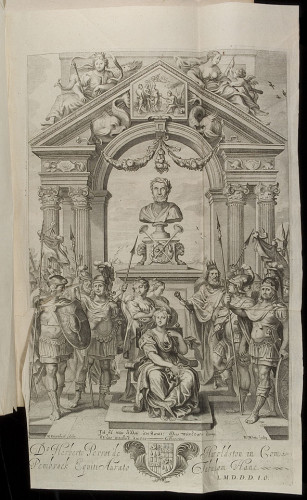
Homer.
His Iliads Translated, Adorn'd with Sculpture, and Illustrated with Annotations, by John Ogilby, Esq; Master of His Majesties Revells in the Kingdom of Ireland. London: James Flesher, for the author, 1669.
The translator and publisher of this luxurious folio edition of the Iliad was the Scotsman John Ogilby (1600-1676), an individual who may have justly claimed to have lived a diverse and flamboyant life. He was a dancing-master, courtier, and theatre owner between 1620 and 1641. He might have danced in Ben Jonson's masque The Gypsies Metamorphosed in 1621, and, around that time, he injured himself and became lame thereafter. In 1633 he moved to Ireland under the patronage of Thomas Wentworth, first earl of Strafford (1593-1641), to become Master of the Revels (a royal office responsible for stage censorship). In 1637, Ogilby opened Ireland 's first theatre, the New Theatre in Dublin 's Werburgh Street . However, with the Irish Rebellion of 1641, Ogilby's good fortune would change dramatically. In that same year, his patron Strafford was executed, and the governments of 1640s and 1650s forbade those theatrical productions in which he had been involved. Following service under James Butler, earl of Ormond (1610-1688), Ogilby returned to England in 1644, first to Bristol, then to Cambridge the next year, and by 1648 he was established in London, the city that would become afterward the center of his intellectual and commercial endeavors. In 1649, he published his first translation of the classics: The Works of Publius Virgilius Maro. London : Thomas Ratcliffe and Edward Mottershed for John Crook, 1649. Although this version appeared as a modest octavo without illustrations, it seems that by that time Ogilby was already conceiving of an ambitious plan to issue scholarly translations of the classics in expensive illustrated editions. Thus, in 1651, he published a translation of Aesop's Fables in a quarto format that included 81 copperplate engravings: The Fables of Æsop Paraphras'd and Adorn'd with Sculpture, by John Ogilby. London: Thomas Warren for Andrew Crook, 1651. And in 1654, he published a great Virgil folio for which he for the first time played the publisher's role to make sure that he received full profits from copyright as well as the sale of the books themselves: The Works of Publius Virgilius Maro. Translated, Adorn'd with Sculpture, and Illustrated with Annotations. London: Thomas Warren for the author, 1654. Ogilby also commissioned prints from the best designers and engravers working then in England : Francis Cleyn ( d. 1658), Wenceslaus Hollar (1607-1677), William Faithorne (c. 1620-1691), and Pierre Lombart (1612/13-1682).
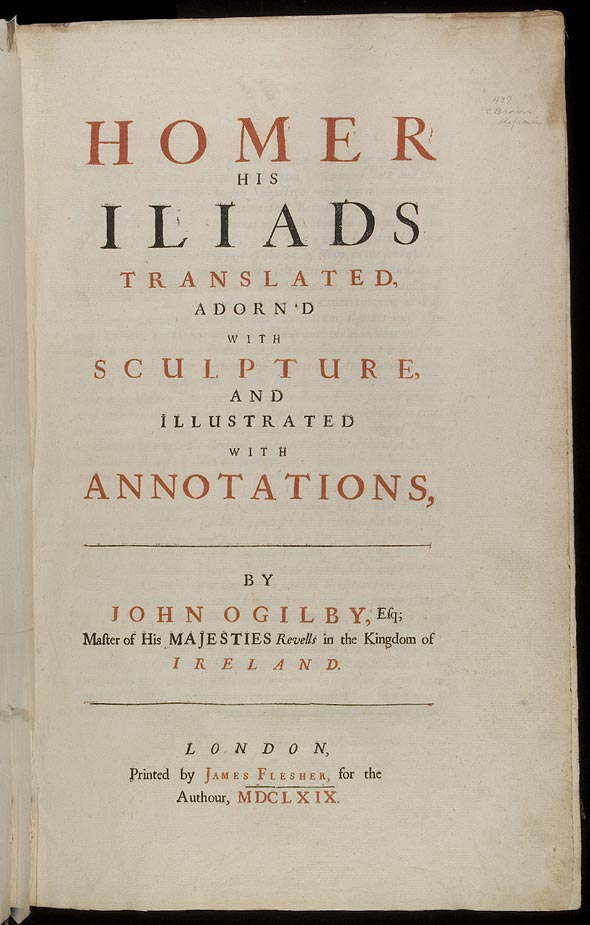
Ogilby's version of the Iliad first appeared in 1660: Homer. His Iliads. Translated, Adorn'd with Sculpture and Illustrated with Annotations, by John Ogilby. London : Thomas Roycroft, for the author, 1660. Five years later, he published his translation of the Odyssey: Homer. His Odysses. Translated, Adorn'd with Sculpture, and Illustrated with Annotations, by John Ogilby, Esq; Master of his Majesties Revells in the Kingdom of Ireland . London : Thomas Roycroft for the author, 1665. Our Collection Highlight is a 1669 edition of the Iliad that replicates the one originally published in 1660, including the dedication to Charles II. In this later edition, Ogilby also repeats the designs of the plates with the names of the dedicatees and their respective coat of arms—however, the 1669 edition contains fewer plates, only 29 as opposed to the original 54 illustrations. Furthermore, a close examination of the engravings of each edition clearly reveals that, in fact, new copperplates were made for the 1669 version. In all probability, Ogilby lost the original copperplates in the Great Fire of London (September 2-5, 1666).
As he had done for the translation of the works of Virgil and Æsop, Ogilby also managed to master previous scholarship on Homer, which he compiled and reproduced by including a life of the poet, a comprehensive list of previous editions of his works, and a critical apparatus in the form of marginal annotations through the text of the poem.
For the life of Homer, Ogilby heavily relied on the legendary tradition that the Greek historian Herodotus (fifth century B.C.) incorporated in a section of his Histories -- clearly echoing some Ionian cities' claims of a part of the Homeric fame. According to this mythical biography, Homer, whose original name was supposed to be Melesigenes, was born in Smyrna, became master of its school under the tutelage of Phemius, and, eventually, gave over the school to travel with the rich merchant Mentes ( "Master of a Ship"). Then the poet visited key locations of the Mediterranean such as Spain, Italy, Ithaca, Colophon (where he became blind) and Cumae (where the poet was first called Homer, since this is the Cumaean term for blind). These visits conveniently allowed him to learn about the local myths and legends he would afterward include in his poetry. The page displayed below describes a curious episode of ancient plagiarism. Having transcribed some poems that Homer had composed in Phocaea, Thestorides recited them as his own in Chios.
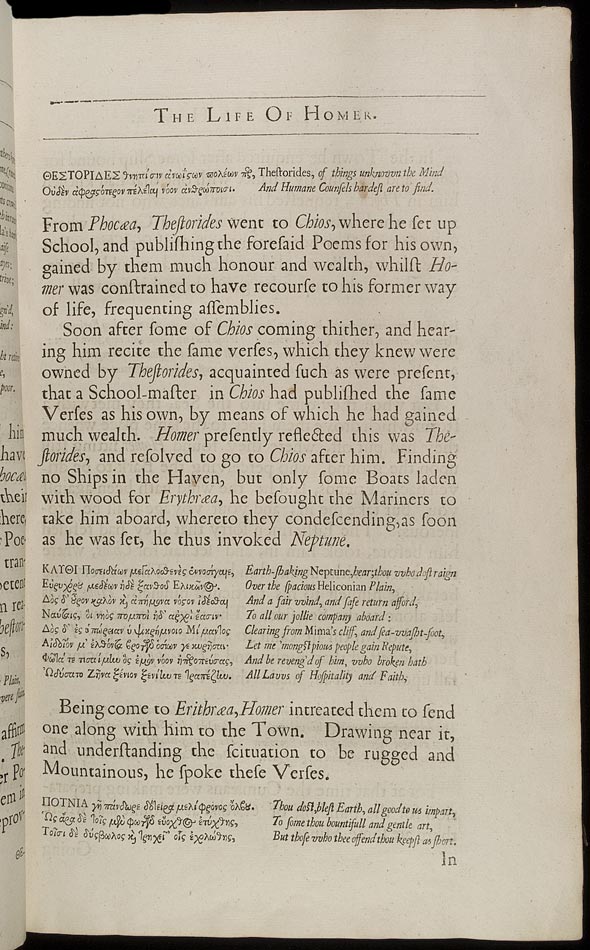
Ogilby's translation of the Iliad, and of other classics in general, was widely read among the members of the educated class. Alexander Pope (1688-1744) claimed that he read it when he was only eight years old:
30. Ogilby's translation of Homer was one of the first large poems that ever Mr. Pope read, and he still spoke of the pleasure it then gave him, with a sort of rapture only on reflecting on it.
"It was that great edition with pictures. I was then about eight years old. This led me to Sandy 's Ovid, which I liked extremely, and so I did a translation of part of Statius by some very bad hand" (Spence, ed. Osborn, 1966: 14).
And, as a subtle homage to Ogilby, he made sure that some of the full-page engravings found their way in the desgn of some historiated initials of his own translation of this work: The Iliad of Homer, translated by Mr. Pope. 6 volumes. London : W. Bowyer, for Bernard Lintot, 1715-20. For instance, the engraving below would be replicated in the historiated initial of book 1 of Pope's edition (Foxon, 1991: 80-1).
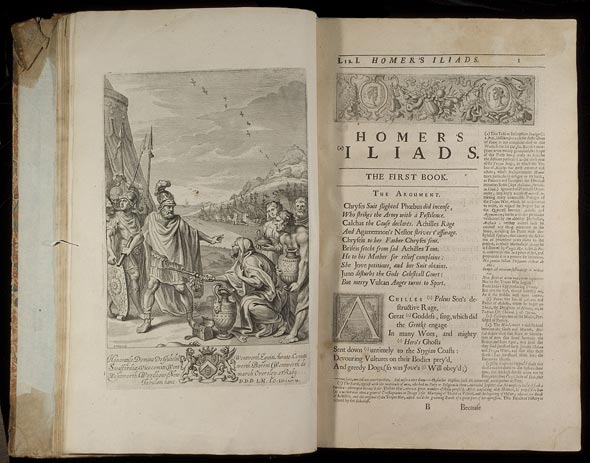
Wenceslaus Hollar prepared five engravings for Ogilby's Iliad (Pennigton, 1982: 39) . The one displayed below captures the moment when, with the Greek ships displayed in the background, Briseis is led away from Aquiles. The caption contains the obligatory dedication for the subscriber, and, following its main Latin text there is the abbreviation D.D.D.L.M.I.O., which is dono dedit dedicavit libens merito Iohn Ogilby (Pennington, 1982: 39). Therefore, the whole text can be translated as "John Ogilby deservedly gave and dedicated this plate (hanc tabulam) to Arabella Wentworth, daughter of Thomas Wentworth, earl of Strafford." On the left corner we can read the following engraved inscription: F. Clein inv. W. Hollar fec. 1656. Thus, the original design can be dated at least four years before the publication of the first edition in 1660.
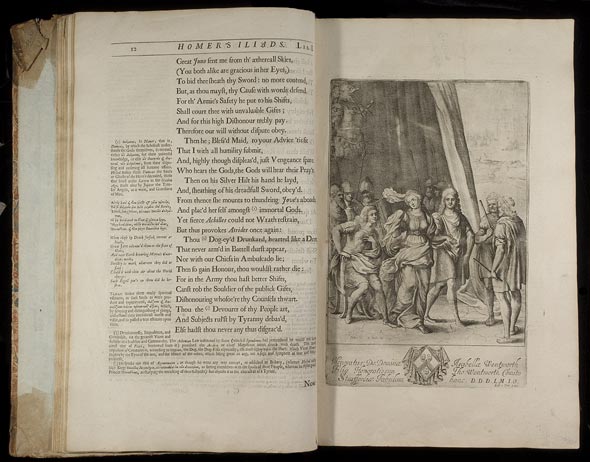
Ogilby was addressing an increasing demand for English translations of the classics in the seventeenth century. Although Latin and Greek were still part of the curriculum, absolute fluency in these languages was not expected, particularly in the Greek language. Overall, students would have a good passive knowledge of Latin, occasionally of Greek as well. Only exceptionally, a distinguished elite of intellectuals and scientists was able to use Latin as a spoken language. For instance, Robert Hooke's diary entry for Saturday, August 30 th (1673) casually mentions how two fellows of the Royal Society conversed with German visitors in Latin.
"Saturday, August 30 th —At Lord Mayors, he orderd Darnelly with me to give them notice to me. left word for Mr. Herne. Directed Warner, Tindall, &c.— with Collet to Whitehall . Lost dinner. at Boyles. at Oldenburgs, the microscope. Germans here with Mr. Haak and Mr. Hill spoke latin. chesse at Mr. Haaks. raine much. writ this account, cleerd with Nell. Went ill to bed. Slept ill." (Hooke, ed. Robinson and Adams, 1935: 58).
Consequently, it is plausible that Ogilby first devoted himself to a serious and systematic study of the classical languages when preparing these translations. And he was then in his late forties! In the preface to his first geographical publication ( Africa: being a Description of the Regions of Ægypt, Barbary, Lybia, and Billedulgerid. London : Thomas Johnson for the author, 1670) he recalls this stage of his life as follows:
Many years are past with various Revolutions, since in the first Fluctuations of the late Grand Rebellion, I being left at leisure from former Imployments belonging to the quiet of Peace wherein I was bred, in stead of Arms, to which in parties most began to buckle, I betook my self to something of Literature, in which, till then, altogether a Stranger; And drawing towards the Evening of my Age, I made a little Progress, bending my self to softer Studies, adapted to my Abilities and Inclinations, Poesie: And first Rallying my new rais'd Forces, a small and inconsiderable parcel of Latin, I undertook no less a Conquest, than the Reducing into our Native Language, the Great Master and Grand Improver of that Tongue," Virgil, the Prince of Roman Poets (c1 r )
To subsidize publications such as this spectacular folio edition of the Iliad, particularly costly because of the quality of both paper and illustrations, Ogilby was one of the first publishers to be fully successful at using a combination of two methods: subscriptions and lotteries.
For instance, an extant book prospectus in the form of a single printed sheet fully describes how Ogilby established the conditions under which different types of subscribers could purchase the 1660 edition of the Iliad, therefore guaranteeing the funding of this publishing venture. Here I have included an extract from this publicity broadside, which is now part of the Anthony Wood Collection at the Bodleian Library:
First, All Persons that shall be pleased to be at the charge of a Design, and graving of a Plate, which will cost the Author at least 10 l. for the adorning and illustrating the Work, are desired to pay into the hands of the Author, or of such as he shall appoint, the summ of 12 l . for which each person shall have two Books; Viz. The Iliads and Odysses; the 12 l . to be paid as followeth; Viz. 5 l . upon the Subscription, and upon the receipt of the Iliads printed 5 l . more, and upon the receipt of the Odysses 40 s . more; each of which Persons upon their said Plates shall have their Names, Armes, and Titles Engraved, and be thankfully Recorded to Posterity, to be Promoters, Benefactors, and Patrons of that Noble Work.
Secondly, Such persons as are not willing to be at the charge of a Plate, and yet are desirous to have the said Books compleat with Pictures, of the aforesaid dedicated Plates, as soon as they shall be published, are requested to deposit in the hands of the Author as aforesaid, the summ of 40 s . upon their Subscription, and upon receipt of the Odysses 40 s . more. To all which Persons the Author shall give Acquitances upon the payment of their first subscriptions, and such order shall be taken for securing the Copies or Volumes before mentioned to the Subscribers, as shall be thought reasonable, being in all 6 l . for the said two Books.
Thirdly, Any Person who by his Interest or Acquaintance shall bring in five Subscribers, or compleat the number himself, on either of the said Proposals, shall upon their payments of their subscribed Summs, have the said two Books of Iliads and Odysses cleer from the Author, over and above the said five, as a return of thankfulness, and be secured thereof as aforesaid (Wood 658, fol. 790; Wing (2 nd ed.) O183; Kiessling 5397; Clapp, 1933: 367-8)
This subscription scheme would be to a great extent echoed in the contract that Tonson and Dryden signed for the publication of the latter's translation of Virgil's works.
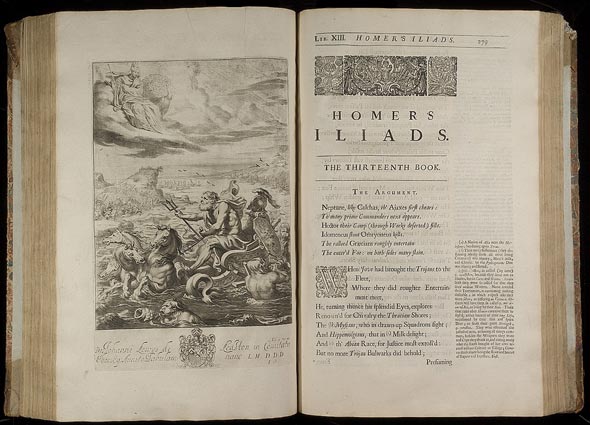
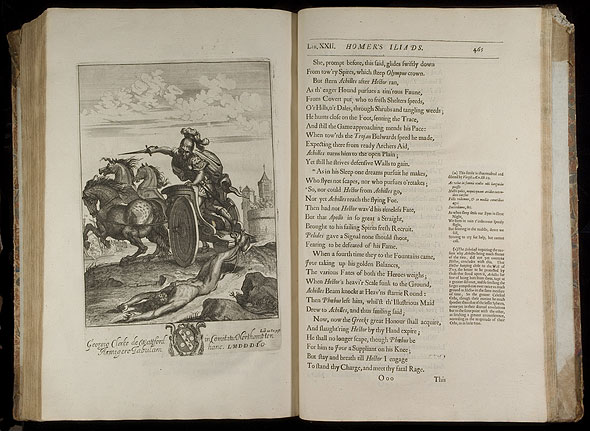
As regards lotteries of books, in 1665 Ogilby obtained the necessary license from the Duke of York. Here, I have included a passage from a one-sheet prospectus for Ogilby's first lottery, 1664:
"John Ogilby Esq; who hath in several years last past, Printed and Published at his own charge, several Volumes of great Value and Beauty, such as our English Imprimarie had been altogether unacquainted with heretofore, viz. Æsop's Fables Paraphrased and adorn'd with Sculptures, Virgil, Prince of Latine Poets, Translated, Illustrated with Notes, and adorn'd with Sculptures; Homer, Prince of all Poets, his Iliads in like manner, set forth and Dedicated to the King's most Excellent Majesty ( A standing lottery of his own books design'd and to be erected by the author, John Ogilby Esq;" Wing (2 nd ed.), O181B ; Eames, 1961:82)
The price for a ticket was 40 s .(or £2): "Whosoever will adventure for a Lot, may be pleased to put in fourtie Shillings,…" Presumably, the prizes were awarded the following year. In his diary entry for February 19,1666, Samuel Pepys wrote: "Thence to the Change, and from my stationer's thereabouts carried home by coach two books of Ogilby's, his Æsop and Coronation, which fell to my lot at his lottery: cost me 4 l ., besides the binding. So home" (Pepys, ed. Latham and Matthews, 1972: 47-8).
By the late 1660s, John Ogilby had already consolidated an extraordinary reputation as a translator and publisher. With the appearance of his atlas Africa in 1670, he began a series of grandiose geographical publications, culminating in his magnum opus: Britannia, Volume the First, or, An Illustration of the Kingdom of England and Dominion of Wales by A Geographical and Historical Description of the Principal Roads thereof, Actually Admeasured and Delineated in a Century of Whole-Sheet Copper-Sculps: Accomodated with the Ichnography of the Several Cities and Capital Towns, and Completed by an Accurate Account of the More Remarkable Passages of Antiquity: Together with a Novel Discourse of the Present Age. London : Printed by the author, 1675.
This blog entry was originally contributed by Pablo Alvarez, Curator of Rare Books at the University of Rochester from 2003 to 2010.
Selected Bibliography
Clapp, Sarah L. C. "The Subscription Enterprises of John Ogilby and Richard Blome." Modern Philology (30, No 4. May, 1933): 365-79.
Eames, Marian. "The Fortunes and Fables of a Seventeenth-Century Virtuoso." Bulletin of The New York Public Library (65, 1961): 73-88.
Foxon, David. Pope and the Early Eighteenth-Century Book Trade. Ed. James McLaverty. Oxford: Clarendon Press, 1991.
Hooke, Robert. The Diary of Robert Hooke. M.A., M.D., F.R.S. 1672-1680. Ed. Henry W. Robinson and Walter Adams. London: Taylor & Francis, 1935.
Kiessling, Nicolas K. The Library of Anthony Wood. Oxford: Oxford Bibliographical Society, 2002.
Pennington, Richard. A Descriptive Catalogue of the Etched Work of Wenceslaus Hollar 1607-1677. Cambridge: Cambridge University Press, 1982.
Pepys, Samuel. The Diary of Samuel Pepys. A New and Complete Transcription Edited by Robert Latham and William Matthews. Vol. 7. Berkeley & Los Angeles: University of California Press, 1972.
Spence, Joseph. Observations, Anecdotes, and Characters of Books and Men. 2 Vols. Ed. James M. Osborn. Oxford: Clarendon Press, 1966.
Van Eerde, Katherine S. John Ogilby and the Taste of his Times. Folkestone, Eng.: Dawson, 1976.
Wing, Donald G. Short-Title Catalogue of Books Printed in England, Scotland, Ireland, Wales, and British America and of English Books Printed in other Countries, 1641-1700. 3 vols. New York : Printed for the Index Society by the Columbia University Press, 1945-1951.

